While place cards marking empty spaces is a typical sight in the museums of Florence, taking a stroll through the Bargello might cause one to wonder if they had missed a Michelangelo fire sale. A significant sampling of the great Renaissance artist’s works have been loaned to a major international exhibition at The Metropolitan Museum of Art in New York.
Even the Met’s highly controversial announcement that the admission fee will no longer be a simple suggestion for patrons could not dull the luster or quell the excitement around Michelangelo: Divine Draftsman and Designer. All signs at the largest art museum in the United States point to Michelangelo as the unadulterated star of the season. The wall-to-wall crowds, who brave Arctic-like mornings in Manhattan, fighting to catch a glimpse of his drawings would make any Florentine proud. With all eyes turned toward this complex exhibit that takes hours to view properly, few visitors have the stamina to make their way beyond the soaring choir screen that spans the medieval gallery and deep into the recesses of a new wing to see a far more mysterious Renaissance treasure. At any other time, in any other museum, it would be the belle of the ball, but here it stands in the shadow of a giant.

Netherlandish? Livia and her infant son Tiberius escape a forest fire (detail from the Tiberius dish from the Aldobrandini Tazze), ca. 1587-99, Gilded silver, Victoria and Albert Museum, London, Dr. W.L. Hildburgh Bequest
While they might not be in the spotlight, there is nothing humble about The Silver Caesars. A Renaissance Mystery exhibition. This breathtakingly luxurious collection of 12 monumental silver standing cups represents the apex of the craft of Renaissance metalwork. The tazze stand more than a third of a meter tall, and while their shape is similar to drinking bowls from antiquity, silverware of this quality was intended only for display. From Julius Caesar to Domitian, each cup celebrates one of the Caesars with inordinately detailed scenes of their achievements as they were described in Lives by Suetonius. The Roman historian filled his colorful account with diabolical deeds, although the scenes on these tazze, crafted in low-relief style, only depict the Caesars’ triumphs. Even Nero’s notoriously bad behavior during the Great Fire of Rome is reframed to focus on the virtue of his support for the arts. And while it seems impossible not to air the dirty laundry of Caligula, who was exceedingly cruel and likely insane, even his tazze manufacture the memory of a generous relationship with the Roman people. These overwhelmingly positive representations would make for fitting centerpieces to adorn the banquets of an extraordinarily powerful Roman family—they quickly found their way into the collection of a Roman family who hailed from Florence.
The provenance of these 16th-century cups is veiled in mystery. Since they would seem to depict scenes based on prints created in 1589, they cannot be older than their publication. We do not know exactly where the silverware was made, the names of the craftsmen or who the original patron was, but the Aldobrandini family was the first recorded owner. The family was quick to proudly add their crest to these treasures. Ippolito Aldobrandini, who was elected Pope Clement VIII in 1592, was born into an eminent Florentine family living in the coastal Marche town of Fano. The fact that he purchased these cups before his rise to the papacy speaks to Ippolito’s bold ambition. The new kid in town with his eye on the papal prize, he wanted to associate himself with the greatest leaders in Rome’s history as he clawed his way to the top.

Netherlandish? The Titus dish from the Aldobrandini Tazze, ca. 1587-99, Gilded silver, Museu Nacional de Arte Antiga, Lisbon
It has been hypothesized that the Hapsburg leader Albert VII of Austria visited Aldobrandini and sold his friend six of the cups; Albert likely gifted the rest of the set. The family kept the tazze until 1769. They later appeared in London in 1826 under the false assumption that they had been crafted by Benvenuto Cellini. But by that point, because the tazze can be disassembled, they had been mixed. Many Caesars were standing over reliefs displaying the achievements of their peers. These scenes contain elements of the 16th century, such as clothing styles and architectural designs that were common to northern Europe. This imagery supports the theory that the cups were cast in the Netherlands before making their way back to Italy. The biggest mystery is how they survived the test of time so well.
One can easily imagine as we gaze at the scene of Julius Caesar halting his army on the banks of the Rubicon river that it would not have been lost to the Aldobrandini that Florence was founded by Caesar’s troops when they built an encampment on the banks of the Arno in an area where it was possible to cross the river. When the Aldobrandini proudly displayed the cups during feasts they would most certainly have proven a historical conversation piece. Candlelight would dance dramatically across glistening triumphal marches passing the monuments of ancient Rome to highlight the military victories of successful leaders. The emperors stand triumphantly in the centers of the tazze surrounded by their achievements. The stories are oriented toward their gaze and not that of the viewer. The Aldobrandini had surrounded themselves with depictions of good omens for their future success in Rome. In one scene, a stray dog gifts Vespasian a human hand during breakfast as a sign that he will be given tremendous power. In another scene, a runaway ox bows before Vespasian acknowledging his future as an emperor. Weighing more than 82 pounds, this silver sat on the Aldobrandini family table like a weighty stack of money.
Netherlandish? The Vespasian figure from the Aldobrandini
Tazze, ca. 1587-99, Gilded silver, Private collection
It is delightfully brazen to put your political ambition right on the table in the form of an illustrated, glittering piggy bank. It is easy to forget in an all-too-quiet gallery how exceptionally rare it is for these 12 cups, normally scattered among private and public collections, to come together in their original splendor, or even that they survived at all. After more than 150 years apart, they will soon be disassembled and separated again. They are a playful reminder that power is always ephemeral.
The Silver Caesars: A Renaissance Mystery
Until March 11, 2018
The Met Fifth Avenue
Robert Lehman Wing, Gallery 955, First Floor









